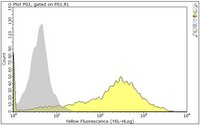MABF977 Sigma-AldrichAnti-ICOS/CD278 Antibody, clone C398.4A
This armenian hamster monoclonal Anti-ICOS/CD278 Antibody, clone C398.4A, Cat. No. MABF977 is validated for use in Flow Cytometry, Function Assay, Immunocytochemistry, Immunohistochemistry, and Immunoprecipitation for the detection of ICOS.
More>> This armenian hamster monoclonal Anti-ICOS/CD278 Antibody, clone C398.4A, Cat. No. MABF977 is validated for use in Flow Cytometry, Function Assay, Immunocytochemistry, Immunohistochemistry, and Immunoprecipitation for the detection of ICOS. Less<<Recommended Products
Overview
| Replacement Information |
|---|
Key Spec Table
| Species Reactivity | Key Applications | Host | Format | Antibody Type |
|---|---|---|---|---|
| M, H | FC, Function Assay, ICC, IHC, IP | AHm | Purified | Monoclonal Antibody |
| References |
|---|
| Product Information | |
|---|---|
| Format | Purified |
| Presentation | Purified Armenian hamster monoclonal antibody IgG in PBS without preservatives. |
| Quality Level | MQ100 |
| Physicochemical Information |
|---|
| Dimensions |
|---|
| Materials Information |
|---|
| Toxicological Information |
|---|
| Safety Information according to GHS |
|---|
| Safety Information |
|---|
| Packaging Information | |
|---|---|
| Material Size | 100 μg |
| Transport Information |
|---|
| Supplemental Information |
|---|
| Specifications |
|---|
| Global Trade Item Number | |
|---|---|
| Catalogue Number | GTIN |
| MABF977 | 04054839049651 |
Documentation
Anti-ICOS/CD278 Antibody, clone C398.4A SDS
| Title |
|---|
Anti-ICOS/CD278 Antibody, clone C398.4A Certificates of Analysis
| Title | Lot Number |
|---|---|
| Anti-ICOS/CD278, clone C398.4A - 3393269 | 3393269 |
| Anti-ICOS/CD278, clone C398.4A - 4012816 | 4012816 |
| Anti-ICOS/CD278, clone C398.4A -Q2735574 | Q2735574 |







